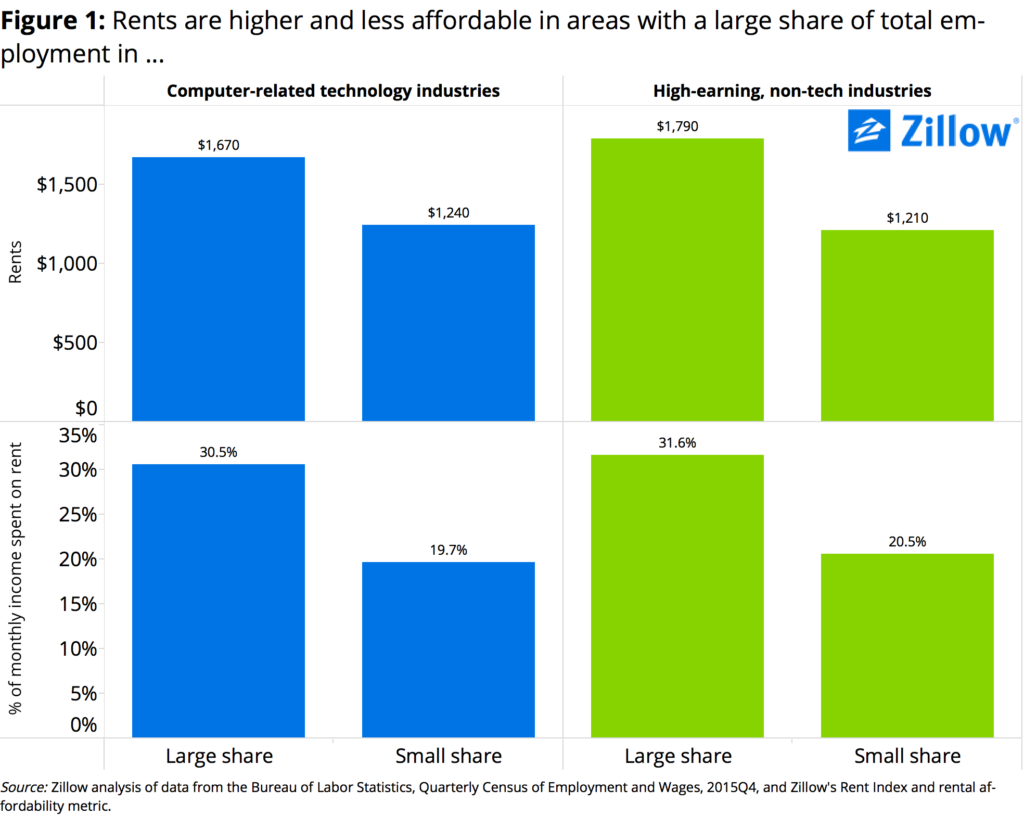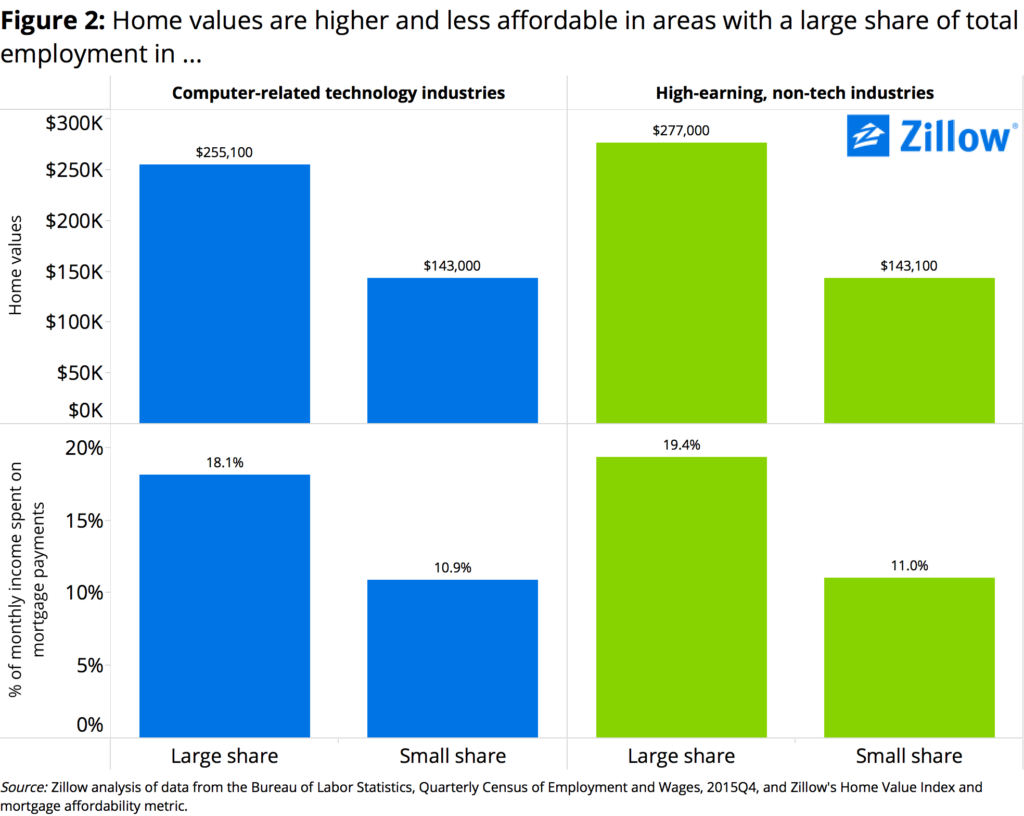As Rents and Home Values Rise in Many Markets, Is Tech Industry Really to Blame?
There is certainly a reason that many people associate the tech industry with pricey and unaffordable housing. In metropolitan areas with a large share of tech workers, rents and home values are considerably higher. But the reality is that expensive housing often follows in areas where a good share of individuals are earning high wages – whether they work in tech, finance, law, or any number of other industries associated with hefty paychecks.
- Housing is more expensive and less affordable in areas where a good share of workers earn high wages – whether in tech, finance, law or any number of other industries typically associated with hefty paychecks.
- Many of the largest metros today with a large concentration of tech workers were once areas with solid high-earning, non-tech employment, making them more expensive and exacerbating the affordability crisis often blamed on tech in these metros.
Across the country, many Americans are feeling the burden of rising home values and rents. And all too often, we play the blame game. Ask anyone in the San Francisco, Seattle, Denver or New York markets, and they will likely point to the tech industry as making their hometown unaffordable.
But is that fair? To a degree, yes – rents and home values have risen and affordability has generally suffered in areas with a large share[1] of tech workers.[2] But it’s not a tech-specific problem, nor is it a new problem: It’s an issue that has persisted now for at least fifteen years.
There is certainly a reason that many people associate the tech industry with pricey and unaffordable housing. In metropolitan areas with a large share of tech workers, rents and home values are considerably higher. But the reality is that expensive housing often follows in areas where a good share of individuals are earning high wages – whether they work in tech, finance, law, or any number of other industries associated with hefty paychecks (figure 1).
 On average, rents are $430 higher in metropolitan areas with a large concentration of tech workers, causing the typical renter in these areas to shell out 30.5 percent of their income towards rent each month, compared to only 19.7 percent in areas where tech is less prevalent. A similar – and stronger – result holds when comparing areas with a large share of high-earning, non-tech workers. Rents in those areas are $580 more expensive per month, on average, than in areas where there are not many high-earning jobs. This means renters in these areas spend an additional 11.1 percent of their income on rent each month relative to their counterparts living in metros with only a small handful of high-income positions.
On average, rents are $430 higher in metropolitan areas with a large concentration of tech workers, causing the typical renter in these areas to shell out 30.5 percent of their income towards rent each month, compared to only 19.7 percent in areas where tech is less prevalent. A similar – and stronger – result holds when comparing areas with a large share of high-earning, non-tech workers. Rents in those areas are $580 more expensive per month, on average, than in areas where there are not many high-earning jobs. This means renters in these areas spend an additional 11.1 percent of their income on rent each month relative to their counterparts living in metros with only a small handful of high-income positions.
Similarly, homes are more expensive and mortgage payments are less affordable when tech or other high-earning workers make up a large share of employment in a given area (figure 2). The effect is again slightly bigger for areas with a denser concentration of high-earning, non-tech workers. In 2015, the typical home in metros nationwide with a large subset of tech workers was worth $255,100, compared to only $143,000 for those areas with fewer techies, a gap of $112,100. In metros with a high concentration of high-earning, non-tech employees, homes were valued $133,900 more than homes in areas with a lower concentration.
 While incomes have a tendency to be higher in places where there is abundant tech or other high-income employment, the larger salaries are not enough to offset the high cost of housing; owning a home is still less affordable, as the typical resident in these places spends a large percent of his income on mortgage payments each month. These results hold if we exclude areas with large concentrations of both tech and other high-earning non-tech industries, or if we restrict the analysis to a subset of smaller metros.[3]
While incomes have a tendency to be higher in places where there is abundant tech or other high-income employment, the larger salaries are not enough to offset the high cost of housing; owning a home is still less affordable, as the typical resident in these places spends a large percent of his income on mortgage payments each month. These results hold if we exclude areas with large concentrations of both tech and other high-earning non-tech industries, or if we restrict the analysis to a subset of smaller metros.[3]
Although these results hold regardless of how we slice the data (see footnote), one might wonder about the interaction between employment changes in tech and other high-earning industries. In particular, it could be argued that tech has created a need for more high-earning, non-tech jobs, as tech companies and their employees often hire financial analysts, accountants, lawyers, higher-priced doctors, etc. This, in turn, could drive up housing costs further and make certain metros even more unaffordable.
Alternatively, there could be an inverse relationship – perhaps tech employers purposely located in metros that already had a large share of other high-earning industries, either because the industry infrastructure was already present or because these places had other desirable qualities. This is one possible explanation for the employment trends experienced by the New York metro over the past several years.
In reality, it is a combination of the two. Over the past 25 years, the share of workers in high-income, non-tech industries has decreased in many of the top 35 metros, while the share of tech workers has increased (figure 3). This suggests that tech has largely grown in areas that previously had healthy employment in high-earning industries. Given that areas with solid high-earning, non-tech employment generally are more expensive, this may contribute further to the affordability crisis often blamed on tech in these metros.
Washington, D.C., for example, has long been a high-earning, non-tech-industry haven. In 1990, 21.3 percent of the Greater D.C. metro area’s working population earned high wages in finance, marketing, consulting services and public relations, while just 1.8 percent of workers earned their living working in tech. Fast-forward to 2015, and tech employment has increased 60 percent while high-earning, non-tech employment has decreased 7.1 percentage-points.
While this trend holds true for most of the top 35 metros, three obvious exceptions are San Jose, San Francisco and Seattle. In these areas, employment in both tech and other high-earning industries have increased significantly, indicating that perhaps some of the tech growth has led or happened alongside more high-earning non-tech growth as well. The compounding effect of gains in both tech and other high-earning employment may be one of many reasons that housing has grown increasingly unaffordable in these areas.
Residents across these metros are experiencing some of the true growing pains associated with such strong economies – their cities are becoming increasingly unaffordable. The burden likely weighs heavy on life-long residents (who have seen the cost of living rise) and on the subset of workers whose wages have remained relatively stagnant over the past ten years. While this is not fair, we cannot vilify one industry for making our beloved cities expensive. It really just comes down to strong job growth overall, particularly in those industries that pay well.
[1] “Large share” (“small share”) indicates that the share of total employment in a given industry is above (below) the national average for that industry.
[2] We define tech workers as individuals who work in the computer-related subset of the high technology industry. For a full list of industries included in this classification or for more details, please visit the Bureau of Labor Statistics: http://www.bls.gov/opub/mlr/2005/07/art6full.pdf.
[3] Home values and rents are more expensive (and rents and mortgages are less affordable) even when we restrict the analysis to subsets of all the metropolitan areas, indicating that the overarching results are not driven by the larger metropolitan areas or geographic differences in housing costs and incomes. Similarly, restricting the analysis to areas that have a disproportionately large share of tech employment (large share of high-earning, non-tech employment) and no high-earning, non-tech employment (no tech employment) does not change the overall results, though the magnitude is muted slightly. This indicates that these findings are not an artifact of high-earning, non-tech jobs frequently being located in areas with a strong tech presence. Further, these results hold over the past fifteen years.


